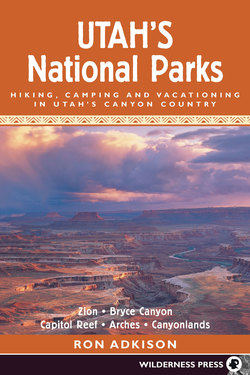Читать книгу Utah's National Parks - Ron Adkison - Страница 12
На сайте Литреса книга снята с продажи.
ОглавлениеDesert Flora
The national parks of Utah, despite their arid-to-semiarid climates, high temperatures in summer and bitter cold in winter, lack of dependable precipitation, and poorly developed soil cover, are home to hundreds of species of plants.
Animal forms, though diverse in numbers and species, are infrequently seen due to their mobility and their mostly nocturnal habits. On the other hand, each plant occupies its own niche in the desert, growing only in a habitat that meets its specific environmental requirements.
It is beyond the scope of this guide to catalog all or even many of the hundreds of plant species visitors are likely to encounter in Utah’s national parks, but the trail descriptions do identify certain plants at various locations. Anyone interested in learning more about desert flora can obtain one or more of the books listed in the bibliography of this book.
Plants of riparian woodlands and hanging gardens (assemblages of water-loving plants found on canyon walls) are hardy enough to withstand extreme heat, but they could be called drought-escaping plants, since they grow only where a continuous supply of moisture is available, either on the surface or underground.
Most other desert plants have developed various methods for coping with extremes of heat and drought. Phreatophytes are plants that have deep, extensive root systems that enable them to tap underground sources of moisture. Once their roots reach the water table, their growth is not dependent on rainfall.
Buffaloberry
Most desert plants, however, are xerophytes. Xerophytes include succulent plants, which have fleshy leaves or stems that enable them to store water for extended periods. Succulent xerophytes include cacti, which have shallow and often widespreading root systems that can take up soil moisture from even the lightest rainfall. Cacti are leafless; their succulent pads are actually stems. These stems swell with stored moisture in spring, and they slowly and economically metabolize that moisture throughout the dry part of the year. When much of the moisture has been used, the stems shrink and become wrinkled, but unlike nonsucculent xerophytes, cacti do not go dormant when stressed by drought.
Nonsucculent xerophytes survive long periods of drought by various means other than water storage. The deep root systems and special cellular structures of some of these plants are able to obtain moisture from the soil long after the rains have fallen. Other characteristics of nonsucculent xerophytes that help to prevent moisture loss and excessive heating of plant tissues include:
vertical orientation of leaves, which reduces the surface area exposed directly to sunlight
dense matted hairs on leaves and/or stems or a resinous coating
a grayish pigment on leaves and stems
very small pores on the leaves
wide spacing of plants
Some plants conserve energy and moisture by curling their leaves or even dropping them. If there is not enough moisture to support the plant, then all but perhaps a single branch will die back, or the entire above-ground plant may die, all of its energies being diverted to preserving the life-sustaining root system. Manyxerophytes have rigid, woody, spiny branches, which, when combined with hairy or resinous foliage, discourage browsing animals from eating them.
In most mountainous regions in the Western U.S., plants are fairly evenly separated into belts, or zones, that vary with elevation, temperature and precipitation. However, the plant communities of the Colorado Plateau are not uniform in their patterns, and likewise the land itself is highly varied, containing deep and sometimes moist canyons, parched mesas and desert flats, vast expanses of naked stone, and sheer cliffs devoid of vegetation and soil.
For example, the pinyon-juniper woodland is one of the most common plant communities visitors will encounter, but this woodland does not grow at any typical elevation; rather, it grows where local environmental conditions are suitable to support it. In Zion National Park, for example, one will find this woodland growing at 4000 feet, while near Canyonlands it is found above 7000. Where a canyon has been eroded into the plateau, one may also find a pinyon-juniper woodland, while above the canyon only a scattering of shrubs may exist.
Bristlecone pine below the rim of the Paunsaugunt Plateau
